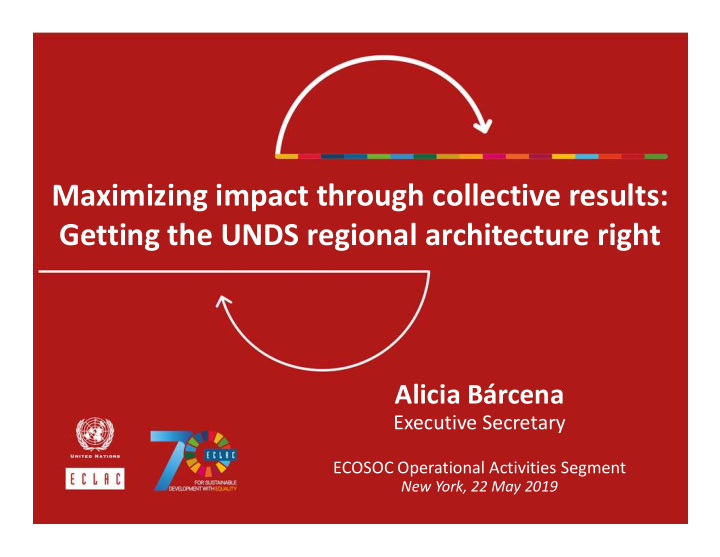



Maximizing impact through collective results: Getting the UNDS regional architecture right Alicia Bárcena Executive Secretary ECOSOC Operational Activities Segment New York, 22 May 2019
Regional value proposition to implement Agenda 2030 • Convening capabilities of intergovernmental sectoral bodies • Regional fora for Sustainable Development • Implementation of Agenda 2030 at national level needs regional integration and cooperation to: Assess gaps and barriers for implementation Reduce financial, technological and trade assymmetries combate tax avoidance and illicit funds address climate change particularly for SIDS Nexus between development, humanitarian and migration • Methods and peer learning on building the SDGs into national development plans, budgets and business models. • Measure what we collectively decide: new indicators • Technical cooperation upon demand to Member States and Resident Coordinators Regional Dimension of the UNDS reform 2019 Alicia Bárcena
Areas for policy discussion, and country-led interagency issue-based coalitions: some examples Climate Change Future of Work Led by ILO Regional common positions on pillars for collective action: Technology and digital revolution Adaptation and resilience Productive sectors and heterogeneity Reforestation Education, skills and training Oceans Collaboration led by ILO and supported Collaboration in the framework of by Regional Commissions COP-25 (Chile, December 2019) Sustainable Cities and New Urban Food security and nutrition Agenda Led by FAO, WFP IFAD, supported Led by UN-Habitat supported by by Regional Commissions Regional Commissions Cross-cutting issues Gender led by UN-Women, education led by UNESCO and UNICEF, equality, financing for development, trade and technology, led by RCP supported by Regional Commissions
National level: UNSDCF
Two examples of on-going subregional collaboration CARIBBEAN FIRST Strategy The Integrated Development Plan northern Central America and Mexico • Options for cooperation for Middle- • Change of paradigm: from national security Income/SIDs Caribbean countries: to human security • Operationalization of the Debt for • Consider the full cycle of migration: origin, climate resilience swap initiative transit, destiny and return • Strategic advocacy on de-risking • Four pillars of action that address the • Support implementation of SDGs and structural causes of human mobility by the Samoa Pathways identifying 6 investment: 3 projects on • Capacity-building for national energy, trade and connectivity and 3 on statistical systems to bridge the data social and environmental protection on safe gap schools, risk management and food security • Continued support for resilience and • Interagency collaboration: 16 AFPs, the UN adaptation Migration Network • Interagency task force including the • Private and banking sectors banking sector
Recommend
More recommend